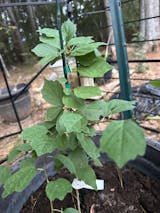
Seedless Che
Cudrania tricuspidata ‘Seedless Che’
(Exclusively from Edible Landscaping)
The Seedless Che (sometimes called Chinese Melon Berry) is a small, round, ornamental fruit tree that bears an abundant crop of bright red, fig-like fruit in the fall. The fruit is juicy, sweet, and pleasantly mild, with a flavor reminiscent of figs. Birds typically ignore the fruit, making harvest easier.
Ripening time varies by region: in the Deep South, fruit matures by mid-July, while in Virginia and similar zones, it ripens from late September through October. Grafted onto Osage orange rootstock, these trees resist suckering and produce superior growth and yield.
Seedless Che is completely seedless, self-fertile, and does not require a male pollinator. It’s a great low-maintenance option for edible landscaping, appreciated for both its fruit and its ornamental value. Trees may exhibit juvenile thorns when young, which typically disappear as they mature.
- Recommended Spacing: 14-foot circle
- USDA Zones: 6–9
Plant Characteristics
- Pest Resistance: Excellent
- Disease Resistance: Excellent
- Drought Tolerance: Very Good
- Heat Tolerance: Excellent
- Humidity Tolerance: Excellent
- Sun Tolerance: Excellent
- Wet Soil Tolerance: Fair
- Shade Tolerance: Fair
- No-Spray Needs: Excellent
- Salt Tolerance: Good
- Kid-Friendly (Fresh Eating): Very Good
- Deer Resistance: Poor
- Thorns: No (may occur in juvenile plants)
- Plant Type: Tree
- Soil Type: Adaptable
- Edible Type: Fruit
- Self-Fertile: Yes
This information is accurate to the best of our knowledge. Comments and feedback are always welcome.


